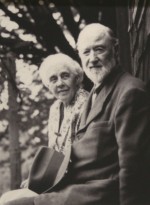Title
Subhead
News that the Juilliard Orchestra would play Charles Ives’s Central Park in the Dark in December afforded an occasion for a field trip. Last spring, the American Academy of Arts and Letters in Upper Manhattan unveiled an extraordinary donation—Ives’s studio, which was painstakingly transplanted and re-created from the composer’s Connecticut house.
Charles Ives's studio has been re-created at the American Academy of Arts and letters in Manhattan.
(Photo by Martin Solarte)The battered Civil War cornet of Ives's father, dented from being thrown in anger, is on display at the composer's re-created studio.
(Photo by Christopher Foss)Body
The 10-foot by 20-foot studio is as much a time capsule of mid-20th century American life as it is a monument to the man who the exhibit’s curator, Vivian Perlis, called “the most original composer in American history.” Ives and his wife, Harmony (yes, really), had built a country house and retreat in West Redding, Conn., in 1913, midway through his 80 years. His grandson donated the studio to the Academy.
An immense trove of materials came with the studio: some 3,000 objects in all. A supplemental exhibit introduces such key Ives comrades as the composers Henry Cowell and Carl Ruggles and the conductor Nicolas Slonimsky.
On the left as you enter Ives’s lair hangs a picture of Ralph Waldo Emerson, avatar of Transcendentalism, a New England-based philosophical movement of the 19th century. Charles and Harmony were avid Transcendentalists; his “Concord” Sonata, one of his best-known works, opens with a movement called “Emerson.”
Ives’s first choice for his country getaway would have been Danbury, the small Connecticut city where he’d grown up and where his father George, a former Civil War bandmaster, made a modest living in music before his premature death. Ives idolized his father, from whom he got his love of polytonality or, as he would put it, “a good dissonance, like a man.” But Danbury had changed too much by 1913 for the nostalgic Ives’s liking; he bought land in nearby West Redding, which retained the flavor of his childhood.
Ives started composing early and became the youngest salaried church organist in Connecticut at 14. He was an enthusiastic athlete at Hopkins Grammar School, captain and pitcher for the baseball team. They actually defeated the Yale freshmen (Ives would become one himself the following year). There’s a photo of that winning Hopkins team tacked onto the studio’s double “saloon” doors, which are festooned with numerous photos and news clippings, some attached by Ives himself. A sign reading Ball Field adorns an opposite shelf; supposedly Ives stole it from Yale. At college, Ives was discouraged by his conventional composition teacher, Horatio Parker, but wrote as he pleased in his free time. A popular student, he enjoyed fraternity life and contributed to school theatricals.
After Yale, unwilling to abide the judgment of musical tastemakers, Ives made his art an avocation and went into the insurance business, where he proved an innovator. Prior to his 1908 marriage, the young Ives shared New York City bachelor pads with former classmates; one was at Central Park West and 66th Street, the perfect locale for picking up ambient sounds to inspire his Central Park in the Dark (1906), which the Juilliard Orchestra will play in its December 11 concert. Like the composer’s famous Unanswered Question, Central Park opens and closes in a wash of soft string chords, an aural landscape of mists and memories. Central Park is also rich in musical quotations, including some from the ragtime hit “Hello! Ma Baby.” Ives’s complex personality had room for a bumptious spirit of fun.
By midlife Ives was rich, but his music, composed in his spare time, was little-known. Though he feigned indifference, he compiled scrapbooks that documented every mention of his music. (His scores and letters are at Yale, but numerous documents, including those scrapbooks, are at the Academy.) Ives bankrolled concerts and publications, his own and those of fellow modernists, a largesse about which he was secretive. Recognition came slowly, but when it did, it was in a big way—Ives won the Pulitzer Prize in 1947 (for his Symphony No. 3, The Camp Meeting). The previous year he had been elected to the American Academy, which inherited his royalties when Harmony died in 1969—and, of course, the studio in 2012. The honors that came late in life hardly mollified Ives, who remained dismissive about “nice” music to the last.
The studio is full of evocative clutter, such as a beautifully wrought stone tomahawk head supposedly found by Ives on a walk around the property. Three canes testify to the frailty of his later years, when the diabetic Ives was in the studio a great deal, at his piano or resting on his cot. Lighter touches include his notoriously battered felt hats. There are also many bottles of bitters, which Ives had imported from Europe during Prohibition; several were found behind the bookcases. The studio was a refuge, where a man could go to compose, or at least to compose himself.
His upright piano, a James & Holmstrom (made in Harlem) became a mouse motel in the nearly 60 years the studio sat unused, but it has been restored to playing condition. Ives’s music cupboards still hold the works of colleagues (plenty of Percy Grainger, an eclectic contemporary who loomed large in Ives’s day). There are George Ives’s two cornets—a later one in its case, with its mute, being in the better condition. But it’s the older, more battered one that speaks loudly of Ives, father and son. That’s the one with the dent in the bell. Supposedly George Ives hurled it one day during the Civil War, while in a towering rage. Relics of the father whose death haunted Ives accentuate the sense of connection his studio gives us to this spiky, uncompromising composer.
The Ives Studio is open by appointment and during the Academy’s spring art exhibitions, which will next run from March 12-April 12 and May 21-June 14, 2015. Email academy@artsandletters.org.







